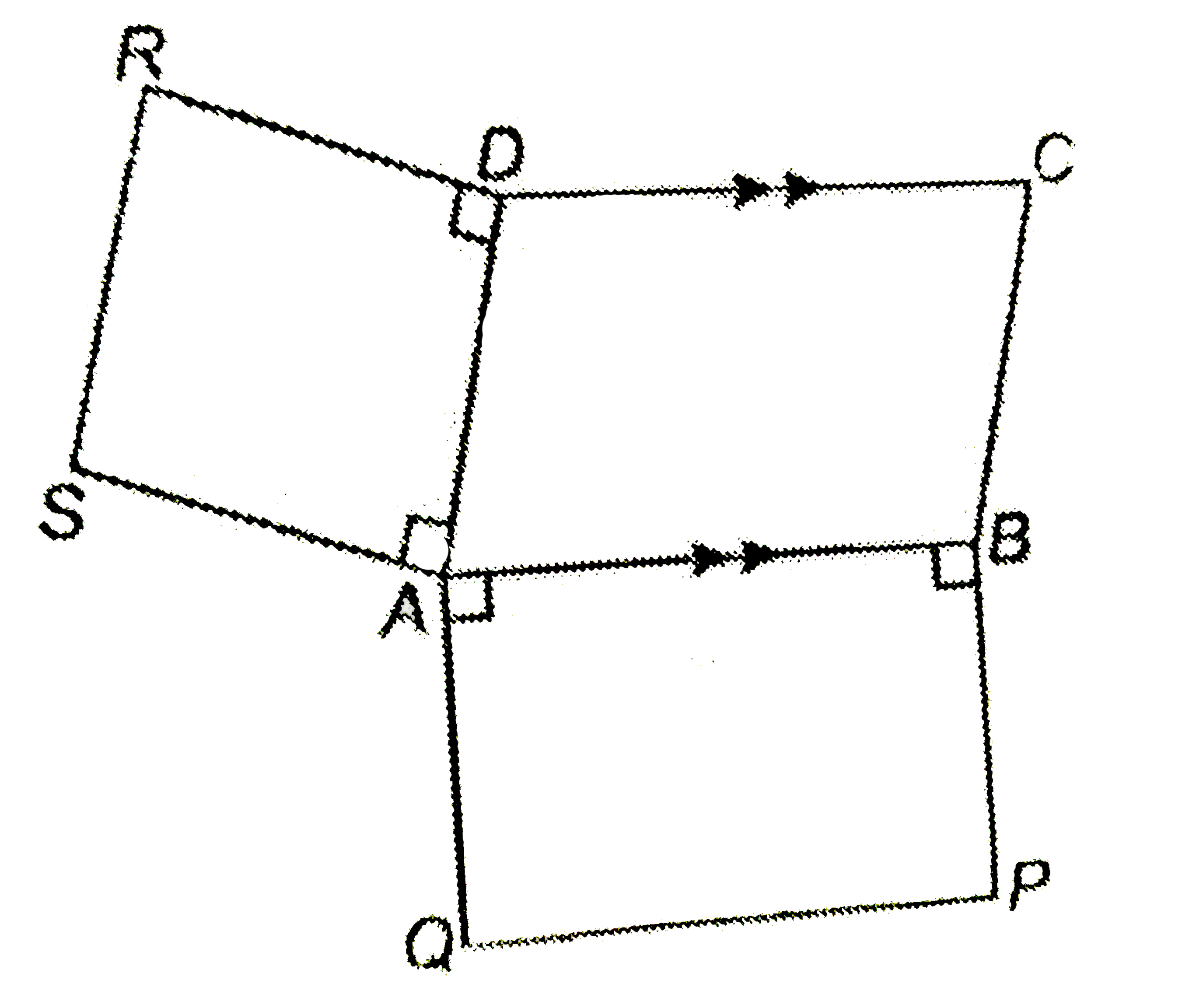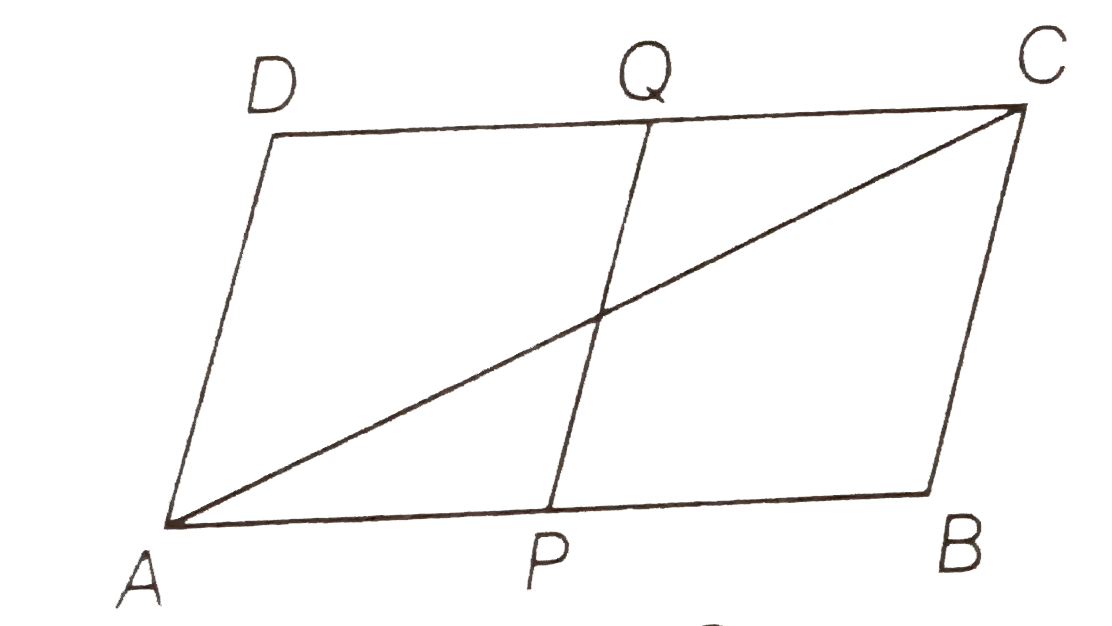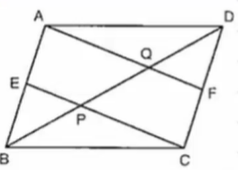ABCD is a parallelogram. Points P and Q are taken on the sides AB and AD respectively and the parallelogram PRQA is formed. If ∠C=45∘, find ∠R.
To find angle R in the parallelogram PRQA, we can follow these steps:
1. Identify the Given Information: We know that ABCD is a parallelogram with angle C = 45°. Points P and Q are on sides AB and AD respectively, forming another parallelogram PRQA.
2. Understand the Properties of Parallelograms: In parallelograms, opposite angles are equal, and consecutive angles are supplementary. Also, if two lines are parallel, corresponding angles are equal.
3. Establish Relationships Between Angles: Since ABCD is a parallelogram, we have:
- AB || CD
- AD || BC
Therefore, angle C (which is 45°) corresponds to angle BCD.
4. Analyze the Smaller Parallelogram PRQA: In parallelogram PRQA:
- AP || QR (since PRQA is a parallelogram)
- AQ || PR
5. Use Corresponding Angles: Since AP is parallel to CD, and QR is a transversal, angle PRQ will be equal to angle BCD. Therefore, angle PRQ = angle C = 45°.
6. Find Angle R: Now, since angle R is the same as angle PRQ (because they are corresponding angles), we conclude that:
- Angle R = 45°.
Thus, the final answer is:
Angle R = 45°.
- AB || CD
- AD || BC
Therefore, angle C (which is 45°) corresponds to angle BCD.
- AP || QR (since PRQA is a parallelogram)
- AQ || PR
- Angle R = 45°.
Angle R = 45°.
Topper's Solved these Questions
- UNDERSTANDING QUADRILATERALS AND PRACTICAL GEOMETRYBOOK - NCERT EXEMPLARCHAPTER - UNDERSTANDING QUADRILATERALS AND PRACTICAL GEOMETRYEXERCISE - APPLICATIONS, GAMES AND PUZZLES
3 Videos
- UNDERSTANDING QUADRILATERALS AND PRACTICAL GEOMETRYBOOK - NCERT EXEMPLARCHAPTER - UNDERSTANDING QUADRILATERALS AND PRACTICAL GEOMETRYEXERCISE - THINK AND DISCUSS
2 Videos
- UNDERSTANDING QUADRILATERALS AND PRACTICAL GEOMETRYBOOK - NCERT EXEMPLARCHAPTER - UNDERSTANDING QUADRILATERALS AND PRACTICAL GEOMETRYEXERCISE - THINK AND DISCUSS
2 Videos
- SQUARE - SQUARE ROOT AND CUBE-CUBE ROOTBOOK - NCERT EXEMPLARCHAPTER - SQUARE - SQUARE ROOT AND CUBE-CUBE ROOTEXERCISE - Exercise
52 Videos
- VISUALISING SOLID SHAPES BOOK - NCERT EXEMPLARCHAPTER - VISUALISING SOLID SHAPES EXERCISE - EXERCISE
91 Videos
Similar Questions
The given figure showns a parallelogram ABCD. Squares ABPQ and ADRS are drawn on sides AB and AD respectively of the parallelogram ABCD. Prove that :
(i) ∠SAQ=∠ABC
(ii) SQ=AC

View SolutionPoints P and Q have been taken on opposite sides AB and CD, respectively of a parallelogram ABCD such that AP=CQ. Show that AC and PQ bisect each other.

View Solution
Knowledge Check
ABCD is a parallelogram. P and Q are mid points of BC & CD. Find the area of ΔAPQ if area of ΔABC is 12.
AtrapeziumBparallelogramCsquareDnone of theseIf P and Q are the middle points of the sides BC and CD of the parallelogram ABCD, then AP+AQ is equal to
AACB12ACC23ACD32ACABCD is a parallelogram, E and F are the mid-points of BC and CD. Find the ratio of area of parallelogram ABCD and ΔAEF
A2:1B4:1C8:3D8:1
ABCD is a parallelogram. Tow points P and Q are taken on sides AD and BC respectively such that AP 13ADandCQ=13BC. Prove that □AQCP is a parallelogram.
View SolutionABCD is a parallelogram. E and F are mid-point of side AB and CD respectively. AF and CE intersect diagonal BD at P & Q respectively. If BD = 15 cm, find PQ.

View SolutionLet ABCD be a parallelogram of area 124cm2. If E and F are the mid-points of sides AB and CD respectively, then find the area of parallelogram AEFD.
View SolutionP and Q are any two points lying on the sides DC and AD respectively of a parallelogramABCD. Show that ar (APB) = ar (BQC).
View SolutionIn Figure, ABCD is a parallelogram. E and F are the mid-points of the sides AB and CD respectively. Prove that the line segments AF and CE triset (divide into three equal parts) the diagonal BD.

View Solution
